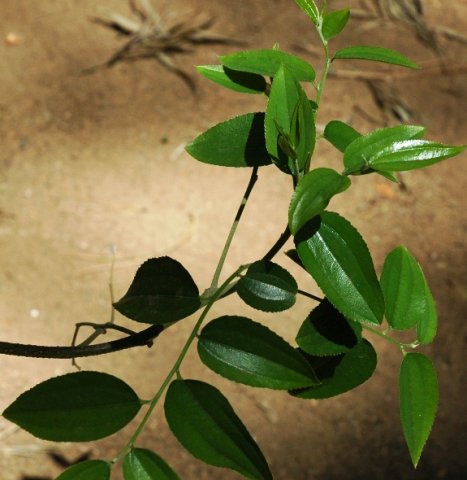Ziziphus rivularis

Author: Ivan Lätti
Photographer: Johan Wentzel
Ziziphus rivularis is known to locals of its distribution range as the river jujube or in Afrikaans the vals-wag-‘n-bietjie (false wait a while). It is a large shrub or small tree reaching about 7 m in height (SA Tree List No. 448).
The jujube name originates from a widely cultivated Asian tree of the same genus, Z. zizyphus, which bears edible fruit resembling dates in appearance and apples in taste.
By a quirk of botanical nomenclature, which forms part of biological nomenclature and is structured as binomial nomenclature, the tree is burdened with the same generic and specific name, spelt differently. The two forms of the spelling are retained according to the convention of the earliest recording of a name not being tampered with, albeit a discarded form or wrong.
This Asian tree is thought to be the same as the lotus tree of Greek mythology, referred to in Homer’s Odyssey as the food of the lotus eaters and therefore known in the Middle East.
The wait a while connotation of the Afrikaans name comes from the well-known and popular South African tree, Z. mucronata or blinkblaar-wag-‘n-bietjie with its formidable pairs of dissimilar spines that both hook and prick those that come too close (like the haak-en-steek of Vachellia tortilis). This compels the momentarily unfortunate passerby to remain stationary while gingerly freeing clothing, hair or skin caught by a spine or spines.
Ironically Z. rivularis lacks spines, therefore the false in the name. It also lacks the edible fruit. Family members differ in attributes, positive and negative. Related facts may feature in names, sometimes strung together by hyphens.
The distribution of Z. rivularis is in the Lowveld of Limpopo and Mpumalanga, continuing southwards through Swaziland into the far north of KwaZulu-Natal, probably also found in Mozambique.
The habitat is among rocks near rivers and watercourses, as the specific name suggests. The species is not considered to be threatened in its habitat early in the twenty first century (Coates Palgrave, 2002; Schmidt, et al, 2002; Wikipedia; http://redlist.sanbi.org).

